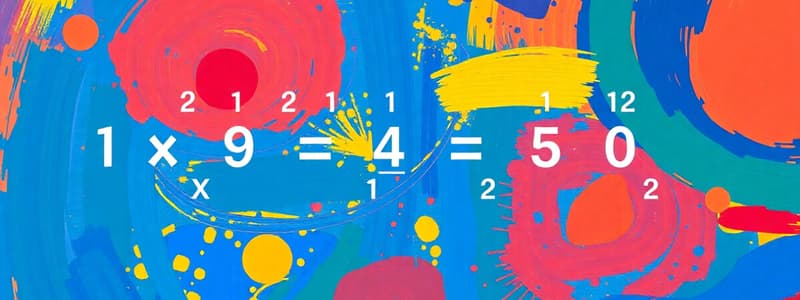Podcast
Questions and Answers
Which subtraction technique involves borrowing from higher place values?
Which subtraction technique involves borrowing from higher place values?
- Counting Up Method
- Traditional Algorithm (correct)
- Equal Additions Method
- Decomposition Method
What is the primary purpose of the Equal Additions Method in subtraction?
What is the primary purpose of the Equal Additions Method in subtraction?
- To simplify borrowing
- To visualize the subtraction process
- To maintain the difference while simplifying the problem (correct)
- To break down the numbers for better understanding
When you are solving 156 - 87 using the Counting Up Method, what would your process mainly involve?
When you are solving 156 - 87 using the Counting Up Method, what would your process mainly involve?
- Using a number line to visualize the numbers
- Finding the difference by subtracting directly
- Counting up from 87 to 156 (correct)
- Decomposing both numbers
Which mental math strategy involves rearranging operations to simplify calculations using properties?
Which mental math strategy involves rearranging operations to simplify calculations using properties?
In identifying Numeric Patterns, what would a ‘growing pattern’ represent?
In identifying Numeric Patterns, what would a ‘growing pattern’ represent?
When solving a word problem, what does ‘identifying key information’ entail?
When solving a word problem, what does ‘identifying key information’ entail?
Which approach is likely the best one for representing problems visually?
Which approach is likely the best one for representing problems visually?
What should be assessed when checking the answer to a word problem?
What should be assessed when checking the answer to a word problem?
Flashcards
Subtraction Techniques
Subtraction Techniques
Different methods for solving subtraction problems.
Decomposition Method
Decomposition Method
Breaking down numbers to make subtraction easier, often mentally.
Equal Additions Method
Equal Additions Method
Adding the same number to both numbers in subtraction to keep the difference the same.
Mental Math Strategies
Mental Math Strategies
Signup and view all the flashcards
Breaking Down Numbers
Breaking Down Numbers
Signup and view all the flashcards
Word Problems
Word Problems
Signup and view all the flashcards
Identifying Key Information
Identifying Key Information
Signup and view all the flashcards
Number Sequences
Number Sequences
Signup and view all the flashcards
Study Notes
Subtraction Techniques
- Traditional Algorithm: Subtracting vertically, borrowing from higher place values when necessary. This is often the first method taught.
- Decomposition Method: Breaking down the numbers to make subtraction easier. For example, subtracting 48 from 92 by subtracting 8 from 12 (92-48 = (90-40) + (2-8))
- Equal Additions Method: Adding the same number to both the minuend and subtrahend. This maintains the difference while making the problem simpler for mental calculations. Example: 137 – 98 = (137 + 2) – (98 + 2) = 139 – 100
- Counting Up Method: Counting up from the subtrahend to the minuend to determine the difference. For example: 156-87. Count up from 87 to 156 (87+13+69)
- Using Number Lines: Visual representation of subtraction, especially helpful for younger students or those struggling with the abstract concept.
Mental Math Strategies
- Breaking down Numbers: Separating numbers into smaller, more manageable components to simplify the calculation. Example: 25 x 4=(20x4) + (5x4)
- Using Properties of Arithmetic: Applying commutative, associative, and distributive properties to rearrange operations for easier calculation.
- Estimating: Using rounding to approximate the answer and check for reasonableness in answer. Example: 32+44 ≈30+40=70.
Numeric Patterns
- Number Sequences: Identifying patterns in sequences of numbers using addition, subtraction, multiplication, or division.
- Number Shapes: Recognizing geometric patterns related to numbers; for example, patterns on the multiplication table, Pascal's triangle.
- Repeating Patterns: Identifying a sequence of numbers that repeats itself. Example: 1, 2, 3, 1, 2, 3...
- Growing Patterns: Identifying number sequences that progress in a predictable way using a constant amount between numbers.
Word Problems
- Identifying Key Information: Deconstructing problems to isolate the given quantities and the question being asked.
- Determining the Operation: Choosing the appropriate mathematical operations (addition, subtraction, multiplication, division) required to obtain the solution.
- Representing Problems Visually: Using diagrams or models to illustrate the problem and make relationships clearer.
- Checking the Answer: Assessing whether the answer makes sense in the context of the word problem.
Number Properties
- Commutative Property: The order of addends or factors does not affect the sum or product. A+B=B+A
- Associative Property: The way numbers are grouped in addition or multiplication does not affect the sum or product. (A+B)+C=A+(B+C)
- Distributive Property: Multiplying a sum by a number is the same as multiplying each addend by the number and then adding the products. A x (B+C) = (A x B) + (A x C)
- Identity Property: Adding zero to a number or multiplying a number by one does not change the value of the number. A+0=A and 1xA=A
- Inverse Operations: Operations that undo each other (e.g., addition and subtraction, multiplication and division).
- Zero Property of Multiplication: Any number multiplied by zero equals zero.
Studying That Suits You
Use AI to generate personalized quizzes and flashcards to suit your learning preferences.




![[2K24] Authentic CheckPoint 156-560 Exam Questions to Pass First Time](https://images.unsplash.com/photo-1533563505784-67329816bc05?crop=entropy&cs=srgb&fm=jpg&ixid=M3w0MjA4MDF8MHwxfHNlYXJjaHw0fHxzdWJ0cmFjdGlvbiUyMHRlY2huaXF1ZXMlMkMlMjBudW1iZXIlMjBsaW5lJTJDJTIwbWF0aGVtYXRpY2FsJTIwcHJvcGVydGllc3xlbnwxfDB8fHwxNzMzMTM0OTkwfDA&ixlib=rb-4.0.3&q=85&w=300&fit=crop&h=200&q=75&fm=webp)